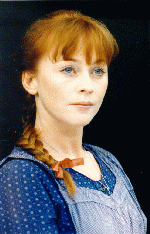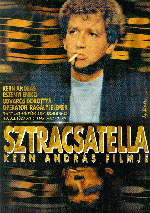
Hungarian Film 1996-97

107 KByte |
I.In the year of 1996, three very different Hungarian films met with unexpected and in their genre overwhelming success abroad. The news that the seven-minute, black and white film of the twenty year old Film Academy student, Marcell Iványi, entitled Wind , had won a Golden Palm in Cannes in the category of short films arrived in May. On a photograph by Lucien Hervé, three women dressed in different costumes stand in the wind, looking in the same direction. Yvette Bíró asked her student to record the before and the after of the eternal moment on the photograph. The image which is recorded with an endlessly slow turnaround, in a single shot, expresses the eternal helplessness and fear felt in the face of history: the camera sweeps the plain and shows the women to be the mute and motionless witnesses of a series of hangings.Péter Gothár's wizardly and unsparing tale about a Russian labour camp, Letsgohang Vaska won an Audience Prize in Chicago and the Great Prize in Karlovy Vary. The film may well be likened to an ancient myth, that of everything that may at any time have happened (and may happen) East of the River Elbe and West of the Ural Mountains. The key to this film's success was the playfulness of expression, magically light-footed as opposed to the director's pervious film, The Division. The third film, Bolshe Vita is a very specific tale. 1989: the moment of the system shift in Eastern Europe. Budapest: the black market of Eastern Europe, the gate to limitless possibilities to freedom, and the rare and peaceful cohabitation of diversity, as long as the Lord, i.e. the Mafia, enters the scene... Ibolya Fekete, whose first film this was, was awarded the Europe Prize (a special prize of the European Parliament) in Berlin and among others the great prizes of the Sochi and the Cottbus Festivals for having recorded this elusive moment of “human-faced internationalism". A few years ago, following a film review, a number of foreign critics concluded that in spite of lamentations and a desperate hunt for funds, Hungarian film has risen again. This conclusion was probably addressed to a few lonely and isolated “fanatics", first of all the fortyish Ildikó Enyedi, Béla Tarr, Ildikó Szabó, András Szõke and János Szász who are still categorised as young. This is the generation which each year brought to the table at least two or three films which are proof to an innovative spirit and talent. This number, compared to a yearly amount of twenty films, is still a good proportion. Yet even these directors have difficulties in raising funds for their next films. While foreign film critics wish to see characteristically Hungarian films, the different distributors of funds see the future in more marketable themes. In 1996, not a single director of first films was given the chance to direct a real feature film.... Hungarian directors have doubtless been searching for new modes of expression for some time. Yet the movement of film-linguistic experimentation hall-marked by the names of Bódy and Jeles did not continue this year, and neither were new films made in the spirit of the directors Szomjas and Grunwalsky who usually turn the genre of box-office hits inside-out in a non-professional, quasi-documentary way. No feature film was directed this year by the fortunately eternally amateur András Szõke, and consequently we could not meet with the magical-grotesque animation of the visual potential of film. Neither did the always experimenting Péter Gothár or Béla Tarr, who is known for portraying the fate of the underdogs of society in a monumental present tense, shoot a film this year. What is typical for this year's yield in film is a reinforcement of the general tendency of Hungarian directors and cameramen attempting to get the traditional themes of Hungarian film (looking back at the past, socio-criticsm, description of the mood of an age) to work in concert with concessions made to the audience as regards genre. (Sándor Simó: Franciska's Sundays, Lívia Gyarmathy: Escaping, Gábor Koltay: Hungarian Conquest, András Kern: Straciatella, András Sólyom: School of Senses, Pál Erdõss: In the Mood for Murder, etc.) The unprecedented public success of Dolly Birds , directed by Péter Tímár, which won the divided first prize of the 28th Hungarian Film Review as well as its audience prize, is proof that the road is the right one. Tímár, with the help of the structuring capabilities of clips and commercials, i.e. the most mercenary of the modes of expressions on film, creates a self-ironic , experimental, asynchronic mode of expression, which helps us laugh at our nostalgia for the by-gone system. (or, for that matter, helps us identify with it). This is a film which “updates" the 60s, an epoch which may well be more beautiful in our imagination today than it really was, reflecting the mood of the current age, by admitting that a “contemporary Hungarian comedy" can only be set in the 60s. Even Sándor Simó almost made it. Franciska's Sundays is perhaps the most beautiful film of his career, portraying the 50s through a private life. The film depicts the love and the days of a house-maid and her one-time neighbour, the middle-aged jeweller who lost his family in Auschwitz. Franciska lives a double life. From the orphaned daughter of a penniless cotter, she advances to become a room-commander of a labour-camp - such are the week-days of self-realisation. Her Sundays are given to her man, and she sees nothing objectionable in the fact that her lover does not “develop" with the age. The idyllic portrayal of history is something new. The individual experiences the extreme alterations in history as well as his own role in it as something entirely natural. Yet the goal of creating an idyllic genre kills the theme. In an age when even the innermost circle of private life was soaked in politics and which turned entirely against private property it is difficult to believe that the “one-time" jeweller could rent out bicycles so unmolested and that no one reported on his “police-woman" lover for her night-time sessions in the goldsmith's workshop. Having recorded his experiences at the labour camp of Recsk in a bewildering documentary made with his wife, Géza Böszörményi and Lívia Gyarmathy now attempted to popularise the theme in the genre of action films. (Escaping). Yet exactly those parts fit ill into this genre which have been the most magnificent moments in their Recsk-film, i.e the specific characteristics of the humiliating order of the Recsk Gulag that take shape as part of the reminiscences. In Escaping, these motifs, in spite of adding extra shade to the psychological background of the characters, feature only as lengthy dialogues or unfinished threads, elements alien to action films. The attempt to harmonise these different perspectives results in a lucky compound in András Kern's Straciatella.. It is the first film of the director who is professional as an actor, and who discloses his own human weaknesses, betrayals and darkened mood in a bitter and self-ironic style, with the sensitive co-operation of Enikõ Eszenyi. The key to the success of the film, beyond Kern's personal charm, his jokes and excellent melodies, is that he fulfils the hope of each of us, i.e. pitying ourselves yet never blaming us for anything, demanding love and giving no love in return..... The other films which portray current problems and are built up according to the clichés of the genre met with less success. Árpád Sopsits Dawning wishes to continue the tradition of popular art films which was successful with Straciatella . In his character Dawning, Sopsits depicts the heroic myth of the “Champion of Truth". The convict stages a passion-play in the prison, in which he plays Maria Magdalena, while out in the real world he sacrifices himself for his beloved, a murderer, and her non-existent child. The story of redemption is told by Sopsits within the framework of a crime story, and he attempts to conceal the consequent confusion by the “secret" of the story, i.e. that its protagonist does not even exist, as he never is seen in the film.... The documentaries Pál Erdõss, in whose films a sensitivity for the topical and a wish to be marketable embrace each other in ever more peculiar ways, processes the theme of general balkanisation on to the clichés of the crime story, the road movie, the Mafia film and the melodrama (In the Mood for Murder). A newspaper article about the repeated disappearance of children is more moving than this badly written hybrid. The television film by Zsolt Balogh about neglected, motherless and fatherless children falls flat because it crams together countless extremities, declared to be part of everyday reality, until it creates disinterest. A typical problem of films about the present is that their shocking over-dimensioning of negativity smother even the last illusion about a truthful portrayal of reality. At the muster of films made in 1996, i.e. the 1997 Film Review, the divided great prize as well as the directors' prize was awarded to a puritan, artistically mature film, deeply personal both in its choice of topic and its formal solutions, i.e. Attila Janisch's Long Twilight, made on the basis of the short story of András Forgách about Shirley Jackson. The double-domed structure of the film emphasises the unexpectedness and wantonness of death. Mari Törõcsik starts from a sunny field of sun-flowers, from the bright little-girlhood of old age to make the last journey on the borderline of existence and non-existence. She embarks on the journey on board of an aged long-distance bus, dreams about her childhood, stands above the dead body of a boy run over by a car in pouring rain, discovers her childhood doll in a rented room of a pub, falls over the mouldy wooden staircase and then everything starts all over again, the same bus with the friendly driver, with the company of archaeologists celebrating a birthday, and then, stepping out of the inner room, the same wooden stair-case.. János Szász's in his film entitled The Witman Boys, made on the basis of Géza Csáth's Mother Murder and other short stories, asks how today's emotionally exiled youth falls prey to the unbearable aggression of our age. With his cameraman, Tibor Máthé , he follows the stations of the road to total dreariness. At the end of the road, the Witman boys live by the nothing else but the rules they set up for themselves. Poetically, the analyses is completely clean. There is nothing to add, and we have nothing to do with the thing. Since the second half of the 80s, three characteristically separate tendencies have been living side by side in film making. In the category of the unmasking of the past, of historical taboos and amnesia 1996 brought some very powerful films, e.g. (János Domokos: Remember, Ágnes Incze's: I Remember a City, István Dékány: My '56, István Lugossy: István Angyal - Tûzoltó street 1956). The writing of “private history" started by Gábor Bódy continues (Péter Forgács: The Swirl), as well as that of social portrayal (András Salamon: Huttyán, Péter Tímár: Shelter Show, István Komár: Necrophilia). Tamás Almási's: The Affair of My Heart - the depiction of the days of a heart-patient waiting for an operation, is the dramatic document of unstaged reality. The dramaturgy of the portrait film made about Dezsõ Tandori calls to mind the playfulness of the poems by the poet. (Gábor Zsigmond Papp: Tandori).
II.It was approximately at the time of the system shift that the old movie theatres disappeared, first from small towns, the outskirts of towns and of Budapest (e.g. in the 15th district of Budapest, not a single movie theatre was working between 1990 and 1996) As the unavoidable concomitant of privatisation and the Americanisation of culture, in 1996 the multi-halled, audience-feeding movie theatre, the multiplex, made its entry on the domestic scene, as part of the new "shopping malls". Here we find perfect technology, the box-office hit, the screening rooms operated in a rotational system on the same footing with the designer paper sachet filled with pop-corn as well as the non-dripping, covered coke glass with a straw, all indispensable elements of this entertainment factory. On the 30th of September, the Corvin Movie Palace was the first to be opened to audiences, and this centre housed the World Reunion of Hungarian Film-Makers in October and the Film Review in February. (At the end of the year, even the 15th district was given its own cineplex of six rooms as part of the shopping mall called the Polus Center.) As experimentalists, the young, the alternative were pushed into the Mûvész Movie Theatre from out of both the venue and the program of the film review, in the same way is a mercenary attitude gaining ground in the Hungarian media and film industry.The disruption of the gigantic conglomerate, MAFILM, (1992) was first felt by the directors and the cameramen, and later by the people responsible for technology, (production managers had left of their free will at the first sinister signs). At first it was a five member consortium, then the fact of incorporation that saved the patented film factory (1994), which in 1995 had no choice but to accept the would-be multinationals (Intercom, MTM Kommunikáció, TMA Ltd.), in order to justify at least its existence. In 1996, in return for shootings on commission, no less than 10 million dollars were received in revenue from foreign contractors. Hungarian film-making did not receive as much as one third of that amount. The Association of Independent Hungarian Producers which amasses twelve Hungarian production organisations an which had a turnover of 1,65 billion in two years, was given only 110 million for its operation by the MMA National Board. Although by now the country has a Media Act, the media war still continues over the ownership of commercial revenues. Hungarian Television, being on the verge of bankruptcy as it is, set up telefilm together with the film factory, which organisation subsidises Hungarian film-making with a yearly budget of as little as 350 million. Is the film factory going to turn into a media yard? By now, the government has a majority ownership only in three studios, (Budapest, Objektív and Hunnia Film Studios), and one sees a proliferation of private film production companies (producing mainly commercials), which are mainly the enterprises of one-time production and shooting managers. Many of them are involved also in feature film making (Magic Media was the producer of Letsgohang Vaska and of Samba, FilmArt Ltd of Return Ticket, Cinemart Ltd of The Woman, Goess Film of Unexpected Death , Magyar Filmiroda Co. Ltd. of The Bad Doctor and Sarajevo Cafe, MAHÍR Film Ltd of The Three Musketeers in Africa, etc.). Small production companies work unnoticed, but the distribution of films which are expected to bring large profit is by now reserved for the really powerful. During privatisation, Budapest Film Co. Ltd was acquired by the Municipality of Budapest (and its board), while the privatisation of MOKÉP Co. Ltd. is still to happen. (since at stake is, among other things, the complete inventory of Hungarian films). Small companies have disappeared, and the survivors all enjoy the support of foreign capital (Intercom, Duna Film, etc.) A continuous presence and a competitive edge can only be ensured by capital concentration, and the surviving and competing distributors - characterised by a markedly American attitude - have the audiences, the reviews, the film weeks as well as the auxiliary actors of the market under their thumb. (In the Corvin Film Palace one cannot get a sandwich, and apart from the quality beer to be drunk beseatedly, only popcorn, coke and tiramisu are for sale... ) The Art Movie Theatre, this symbol of the hypocrisy of Western culture, operates of course as part of this structure, too. Here, the game is on in who gives to whom and why - under the pretext of subsidising the distribution of art films. While certain Western countries devote caring love to and specifically prefer their own national film-industry by side of business, i.e. the American film which produces extra profit, on the domestic scene the number of copies and screenings prove that Hungarian film is a step-child. The invisible war for film rights is being fought. The result of the war has not been decided. An impossible situation. How can the ownership of the national inventory of films be questionable?
III.On the stair-case rising to the sky, the digitised rolls of film bounce softly down. The computer plays the tunes of the accompaniments of silent films. The screen shows István Szabó. He wants to make us believe that the most important event of the year is that “it is a hundred years of film!"For an entire year, the inhabitants of Budapest and half the county has been sitting in front of their television sets on each Tuesday, Thursday and Saturday in order to see and the next day discuss on the bus the pieces of István Szabó's history of world film, films they had seen long ago, seldom or never at all. On December 28th, 1995, Paris celebrated the real birthday of film, among others, by András Szirtes's Lumiere-Rolls. The director made his memorial film with a contemporary camera and in a contemporary laboratory, on the sites where the Lumieres had worked. The film was screened with a contemporary device. For the 100th birthday of film, with international co-operation and subsidies from the Lumiere Foundation, another pearl of Hungarian film history was saved from decay, i.e. Béla Balogh's silent film made in 1920, entitled The Fourteenth. The wonderfully brownish visual world of this wild-romantic melodrama, modelled after the fashion of the American school, became visible as a result of international co-operation. A restored Hungarian silent film appeared for the first time in Pordenone, this picturesque small town of Northern Italy, coupled with an impressive national program. As a result of six months' continuous work of corrections, the audience could see the full version of the visually most impressive Hungarian film, Gábor Bódy's masterpiece entitled Psyche, in the movie theatres for the first time. This opening encyclopaedia of the era of the post-modern was at its time juggled away by the “reform communist" Hungarian cultural government , - in solidarity with Jaruzelski's martial law, and the largest part of the original negative required for a restoration became destroyed. Now, with the co-operation of the full spectrum of professionals, the full version as was envisioned by Bódy was restored. In 1996, Miklós Jancsó became seventy-five years of age. How could his birthday have been better celebrated than by the restoration of one of his epoch-making films, The People Are Still Asking for More, which the French called the “messianistic opera of the spirit of revolution"? The restoration of his oeuvre is halfway finished. The Hungarian Institute of Film celebrated the 100th anniversary of film, among other things, with the issuance of a film-historical CD-ROM. With a state-of-the art digital technology, the series evokes the treasures of Hungarian film and makes them available to the general public. The disc connects the concepts of the multimedia to the phenomena of the moving picture, creating the illusion of being a book, a video and a gramophone record at the same time. The first disc covers the golden age, i.e. the feature films from the beginnings to 1944. 1996 was not only the centenary of film, but also the 1100th anniversary of the Hungarian Conquest. As part of the series of celebrations, the world reunion of Hungarian film-makers took place at the same time with the meeting of the cultural ministers of European countries in Budapest. Who would have known better than the visitors, e.g. Tony Curtis, Vilmos Zsigmond and János Badal, that the saying often cited in Hollywood and across the world is true: “It is not enough to be Hungarian, you must also have talent". (Only their hosts know better than them, that: “If you have a Hungarian friend, you no longer need an enemy..."). On the occasion of the event, a lexicon-like publication was issued for the first time about Hungarian film-makers living abroad, in Hungarian and in English, published by Magyar Filmunió. ... For the 100th. anniversary of film, a French documentary was made. In one of the episodes, the then already fatally ill Francois Mitterand is asked what film means to him. He answers musingly - "Film is an image to me. It is from a Hungarian film, I have forgotten its title, I see a dancing couple in front of me. It was wonderful. That dance is film to me"... |

96 KByte | |

119 KByte | |

51 KByte | |

63 KByte | |

137 KByte | |

181 KByte | |

256 KByte | |

141 KByte | |

39 KByte | |

43 KByte | |

118 KByte | |

69 KByte |